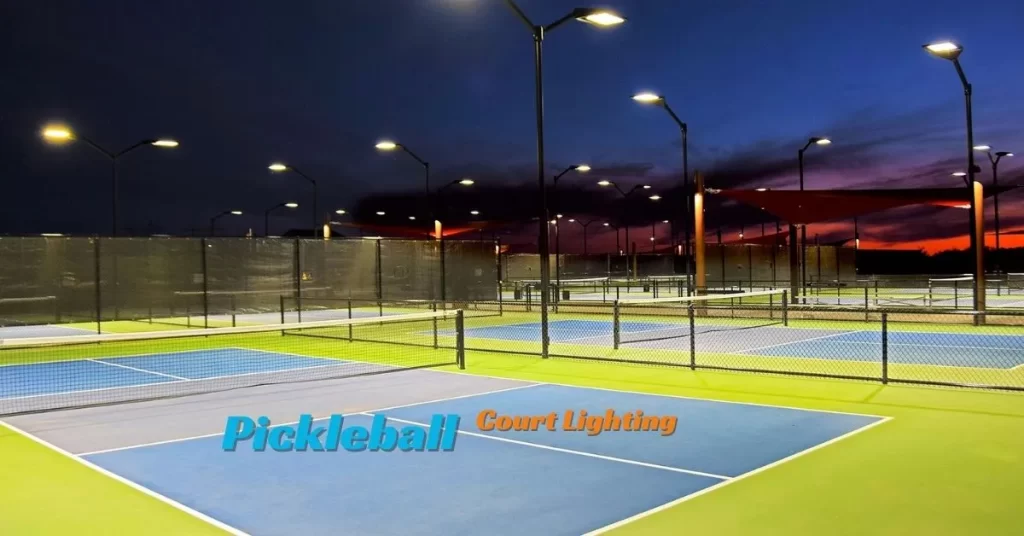
Pickleball is one of the fastest-growing sports in the country. As more and more people discover this fun sport, the demand for dedicated pickleball courts is on the rise. But in order to play pickleball at night or on overcast days, proper pickleball court lighting is a must. In this blog post, we’ll cover everything you need to know about lighting a pickleball court so you can keep the game going even after the sun goes down.
Pickleball Court Lighting Cost
Chapters
ToggleOne of the first things you’ll want to consider is the pickleball court lighting cost. Prices can range dramatically based on the size of your court, the type of lighting you choose, and whether you do the installation yourself or hire an electrician. Generally speaking, you can expect to spend anywhere from $2,000 to $8,000 or more on lighting a regulation-size pickleball court (20×44 feet). The lights themselves will be your biggest upfront expense. But you’ll also need to factor in poles, wiring, switches, and any labor costs for installation. Doing the work yourself can save thousands over hiring an electrician.
Pickleball Court Lighting Requirements
Proper pickleball court lighting requirements are important for visibility, safety and enjoyment of the game. The recommended light level for recreational pickleball play is 30 foot-candles. For tournament play, 50 foot-candles may be required. Uniformity of light coverage across the court is also key. The lights should be arranged to minimize shadows on the court itself. LED sports lighting is the best choice today for its energy efficiency, durability and quality of light. Poles should be spaced appropriately around the perimeter of the court to provide optimal light coverage across the entire playing surface.
Tennis Court Lighting
You may be wondering if you can simply use tennis court lighting since pickleball courts have similar dimensions. It’s true that lighting designed for tennis can sometimes be adapted for pickleball. However, there are a few potential drawbacks. Tennis court lighting is usually designed to accommodate a wider playing area. This can result in uneven light coverage or shadows on a pickleball court. The light levels may also be higher than necessary, resulting in glare and wasted electricity. Purpose-built pickleball court lighting will provide a better experience at a lower operating cost.
How Many Lumens for Pickleball Court
When shopping for pickleball court lights, you’ll see lumens mentioned frequently. Lumens simply refer to the total amount of light emitted in all directions. But what matters most is the number of lumens that actually land on the playing surface (also known as foot-candles). As a general rule of thumb, how many lumens for pickleball court lighting should be around 8,000 to 12,000 lumens per fixture. Higher lumen fixtures may be required for larger courts or to achieve maximum light levels for tournament play. Your lighting supplier can help calculate the ideal fixture and lumens after evaluating your unique court size and layout.
Pickleball Court Dimensions
Understanding the official pickleball court dimensions will also inform your lighting needs. Per USAPA guidelines, regulation pickleball courts are 20×44 feet for both singles and doubles play. The court is divided into right and left service courts of 10×44 feet. These compact dimensions make pickleball ideal for smaller spaces compared to tennis. However, the shape and size of the court will impact the spacing and location of lighting poles to eliminate shadows or dark spots in the playing area.
LED Pickleball
For the best combination of light quality, efficiency, and longevity, LED pickleball court lights are the way to go. LED technology has revolutionized sports lighting. The light is very bright and evenly distributed. LEDs also draw far less electricity than older metal halide or high-pressure sodium fixtures. With a lifespan of up to 100,000 hours, LED lights virtually eliminate ongoing maintenance or bulb replacement costs. The upfront investment in LED pickleball court lighting will pay dividends for many years down the road.
LSI Pickleball Lighting
One company leading the way in purpose-built LSI pickleball lighting is LightStone Innovations. LSI offers an entire product lineup designed specifically for pickleball courts. Their lighting solutions are engineered to provide unmatched light quality and distribution. By consulting with actual pickleball players, LSI has developed fixtures that enhance visibility and playability. Products like the Legend Series area lights and Wall Blaster perimeter lights are cost-effective options to illuminate any indoor or outdoor pickleball venue.
Asphalt Pickleball Court
For outdoor pickleball courts, an asphalt pickleball court surface provides a smooth yet forgiving playing surface. Asphalt is also ideal for consistent bounces and ball rolls compared to concrete or other materials. The smooth surface enables easy running and mobility for players of all ages. Asphalt’s dark color will nicely absorb light from overhead fixtures, reducing glare on the court. Proper asphalt finishing and periodic sealing will keep the court looking great for many seasons. Lighting paired with asphalt is a winning combination for outdoor pickleball.
Getting the proper lighting for your pickleball court or facility enables play around the clock. With the sport’s popularity booming, lighting allows you to maximize utilization of your court and provide more opportunities for picklers to enjoy their favorite game. Following the recommendations and guidelines above will ensure your lighting investment provides the visibility and performance both recreational and competitive players demand. So you can keep the volleys going even when the sun goes down.
FAQs
The ideal lumens can vary, but a range of 50,000 to 70,000 lumens is generally recommended for optimal visibility.
While the upfront cost of LED lights is higher, their long-term energy efficiency and reduced maintenance costs often make them a more cost-effective choice.
In many cases, yes. Retrofitting can be a viable option, but it’s essential to consult with a professional to ensure compatibility.
Opt for lighting fixtures with shields to direct light downward, minimizing spill and reducing light pollution.
LED lights typically have a lifespan of 50,000 to 100,000 hours, making them a durable and long-lasting choice.
Sharing is caring!
